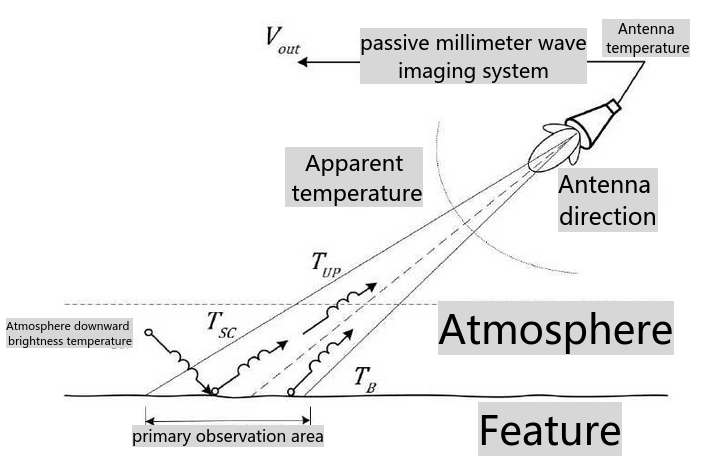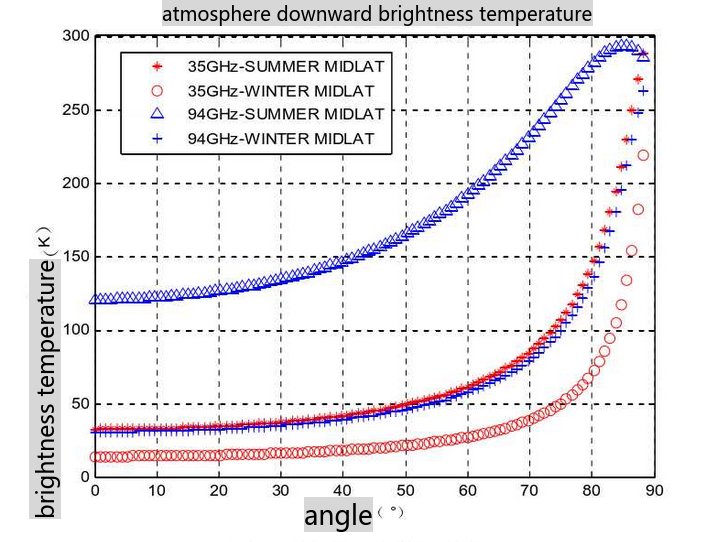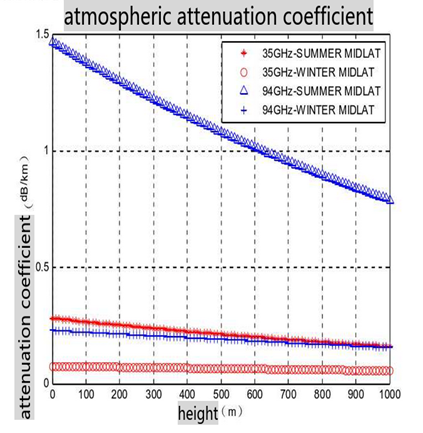1. Introduction
Millimeter waves usually refer to electromagnetic waves with frequencies between 30Ghz-300Ghz and wavelengths of approximately 1mm-10mm. The millimeter wave is located between the microwave and infrared frequency bands, with a bandwidth of 273.5GHz. Even considering atmospheric absorption, there are still at least four propagation windows within the millimeter wave range. The most prominent advantage of passive millimeter wave imaging compared to infrared radiation and visible light is that in extreme weather conditions such as fog, smoke, snow, and sandstorms, the attenuation is several million times smaller than the latter. Millimeter wave radiometers not only have rich image information but also receive signals that are difficult to detect, greatly enhancing their survival ability in military operations [1]. Therefore, millimeter wave imaging reduces the incidence of traffic accidents in low visibility and provides a key advantage for detection tasks in this context. Moreover, millimeter wave has strong penetrability, which can be used to detect targets buried in the shallow underground. Metal will be very protruding in the millimeter wave imaging chart because its effective radiance is very low. In addition, passive millimeter wave imaging is very safe for the human body because it does not emit radiation and only accepts millimeter waves. It also has different radiation characteristics for different materials, making it easy to distinguish objects from the background and the human body from their belongings. The paper aims to provide a general overview of passive millimeter wave detection imaging technology, especially in low-altitude fields, enabling readers to have a preliminary understanding of the principles, characteristics, and applications of this technology.
Passive millimeter wave low altitude detection technology has many advantages in some special situations, especially in low visibility, but there is still a lot of room for development and some shortcomings. With the optimization of detection strategies and algorithms, this technology can also be used to detect hidden targets.
Radiation Surveying is the science of electromagnetic radiation measurement. A large amount of energy received by the earth comes from the electromagnetic radiation of the sun [2]. According to the quantum theory of radiation, all substances in nature will spontaneously radiate electromagnetic energy as long as their temperature is higher than Absolute zero. This energy comes from two sources, one is its own thermal radiation, and the other is electromagnetic radiation that reflects other radiation sources [3]. The ability of an object to emit, absorb, and scatter electromagnetic radiation is closely related to its internal geometry, temperature distribution, and the relative dielectric constant of its components [4]. Generally, the sum of the absorptivity and emissivity of an object is 1, which is the embodiment of the conservation of energy. Then the black body is defined as an ideal completely opaque object that can absorb all the incoming electromagnetic radiation energy without any reflection. In addition to being a completely absorbed body, the black body is also a complete emitter. According to Planck’s law, the black body is uniformly radiated in all directions, and the spectral brightness of the black body has a certain functional relationship with its temperature and frequency. The specific expression is as follows [5]:
\( {B_{f}}=(\frac{1}{{e^{hf/kT}}-1})\frac{2h{f^{3}}}{{c^{2}}} \) (1)
From the above equation, it can be seen that there are only two factors that affect the width of the blackbody radiation spectrum, namely temperature and frequency.
As the temperature T increases, the overall level of the blackbody spectral brightness curve also increases. Compared with infrared, the radiation intensity in the millimeter wave frequency band is very weak. When the frequency f is very low and hf/kT is much less than 1, the Rayleigh-Jeans formula can be obtained by expanding the Taylor formula:
\( {B_{f}} \) = \( \frac{2kT}{{λ^{2}}} \) (2)
From the above equation, it can be concluded that when the frequency is in the two commonly used millimeter wave frequency bands of 35GHz and 94GHz, the error between the results calculated using this formula and the results calculated using Planck’s formula is very small. It can be considered that in the millimeter wave frequency band, the radiation intensity of a blackbody is directly proportional to its physical temperature, so its radiation intensity can be expressed by its physical temperature.
2. Passive Millimeter Wave Low Altitude Detection Technology
2.1. Basic model
The main carrier of millimeter wave low altitude detection is small unmanned aerial vehicles (UAVs), which are widely used in aerial photography, rescue, agriculture, military and other fields. They can detect high-risk areas that are nearly impossible for users to reach at extremely low costs.
The altitude of the low altitude detection model is less than 1km. The thermal radiation signals of ground objects and targets are received by the detection system after atmospheric attenuation, and the detection system also receives the upward sky brightness temperature in that direction. The thermal radiation signals of ground objects and targets are composed of surface reflection, surface self-radiation, target self-radiation and target reflection. According to the geometric relationship and observed physical quantities in Figure 1, the antenna temperature is composed of apparent temperature and antenna direction. To establish mathematical connections between various physical quantities and deduce the difference in temperature between the target and background, it is necessary to first calculate (1) the atmosphere’s downward brightness temperature in each spatial angle direction, (2) the atmospheric attenuation in different observation heights and spatial angle directions, and (3) the effective emissivity of different ground object backgrounds and targets.

Figure 1. Geometric relationships and observed physical quantities [6]
2.1.1. Atmospheric downward brightness temperature. Simulation calculations were conducted using the water vapour, temperature, and pressure parameters from the mid-latitude of summer and mid-latitude of winter in the 1976 US Standard Atmosphere [7]. According to the simulation results (Figure 2), it can be concluded that the downward brightness temperature of the atmosphere increases with the increase of the incident angle. If the incident angle is less than 40°, the change is small. Therefore, maintaining the incident angle of less than 40 ° is beneficial for the stability of drone imaging. Secondly, there is also the issue of frequency band selection. Under the same atmospheric environment, the downward brightness temperature of the 94GHz frequency band in summer is about 100K higher than that of the 35GHz frequency band in summer, so the brightness temperature difference between the target and the background will be reduced by 100K. From this perspective, choosing a 35GHz system is better; But the resolution of a 94GHz system is three times higher than that of a 35GHz system, so 94GHz is generally chosen.

Figure 2. Atmosphere downward brightness temperature [7]

Figure 3. Atmospheric attenuation coefficient [7]
2.1.2. Atmospheric attenuation. When the altitude is constant, the total atmospheric attenuation is related to the atmospheric attenuation coefficient and angle direction. Referring to the ITU-R P.676-7 atmospheric attenuation coefficient calculation formula for simulation, it can be concluded from the analysis (Figure 3) that the atmospheric attenuation coefficient in summer at 94GHz and mid-latitude will be used as the reference frame for designing the system, as it is the highest among the four climates, making it easy for the system to adapt to multiple climates. Moreover, as the height increases, the atmosphere becomes thinner, and the atmospheric attenuation coefficient decreases accordingly. At the same altitude and frequency band, the atmospheric attenuation in summer is higher than that in winter, because the atmospheric moisture content in summer is generally relatively high.
2.1.3. Millimeter wave thermal radiation characteristics of different targets and backgrounds. According to Holkiev’s law of thermal radiation, it is known that the absorption rate of a ground object is equal to the emissivity. When observed from the air to the ground, the radiation temperature on the ground surface can be expressed as the physical temperature, and the downward brightness temperature of the atmosphere. As shown in Figure 2.3, the emissivity of metals is very low, and their brightness temperature mainly comes from the downward brightness temperature of the atmosphere, which reflects the brightness temperature of the sky, so the brightness temperature of metal targets is low. The brightness temperature of the surface background mainly comes from its own physical temperature, with high brightness temperature. Therefore, metals are easily distinguishable from the background [8].
Table 1. Effective emissivity of commonly used substances at different frequencies [9]
Surface | Bare metal | Painted metal | Painted metal under canvas | Painted Metal under camouflage | Dry gravel | Dry asphalt | Dry concrete | Smooth water | Rough or hard-packed dirt | |
Effective Emissivity | 44GHz | 0.01 | 0.03 | 0.18 | 0.22 | 0.88 | 0.89 | 0.86 | 0.47 | 1.00 |
94GHz | 0.04 | 0.10 | 0.24 | 0.39 | 0.92 | 0.91 | 0.91 | 0.59 | 1.00 | |
140GHz | 0.06 | 0.12 | 0.30 | 0.46 | 0.96 | 0.94 | 0.95 | 0.66 | 1.00 |
3. Hidden Target Detection
3.1. Existing problems
This chapter proposes a strategy for detecting hidden objects in millimeter wave images based on the application requirements and existing problems of detecting prohibited items such as hidden metals.
For the detection of hidden targets using passive millimeter waves, the radiation characteristics of dangerous targets and covers in passive millimeter wave images are significantly different, which makes it possible to detect hidden targets. Taking the human body as a cover as an example, the following issues are particularly prominent:
Due to the influence of the target, background radiation characteristics and cover, the original image is relatively blurry and the background boundary is not clear enough. In addition, passive millimeter wave images have the drawbacks of low spatial resolution and low signal-to-noise ratio caused by speckle noise, resulting in low imaging quality.
The direction and speed of target movement are randomly influenced by the human body which is difficult to predict. On account of the fixed position and limited imaging angle of the passive millimeter wave imaging system, it may be unable to identify targets in some frames of the image. At the same time, the continuous movement of the human body changes the distance between the target and the imaging system, and the size of the detected hidden target changes accordingly.
Passive millimeter wave images contain complex backgrounds, which can contain many objects with different levels of radiation energy. The two are easily distinguishable though they have different radiation characteristics from the target to be detected. However, other objects outside the human body area may have similar radiation characteristics, making it hard to find the needed one from a large number of potential interference targets in the background. If the target is directly detected, it is easy to be missed due to background interference.
For target detection in passive millimeter wave images, because of the possibility of unknown objects blocking the human body at random, the condition of target loss and then the inability to detect the target may occur. At this point, the danger of hidden targets has not been eliminated. If the detection result is determined to be safe, it will bring incorrect instructions.
According to the analysis of hidden target detection in millimeter wave images, if hidden targets are directly detected in the image, it will be difficult to accurately detect hidden targets due to the existence of the above problems, and the processing computation of the entire image for each frame in the sequence image is large, which is not conducive to real-time processing of batch data.
3.2. Detection Strategy and Prospects
One solution of hidden target detection involves separating the target from the background and extracting the target. The hidden target and human body have adhesive properties, that is, the appearance of the target is always accompanied by the appearance of the human body, and the separability of the human body and the target can be guaranteed by the different radiation characteristics of their respective millimeter wave bands. Therefore, the detection problem of hidden targets in passive millimeter wave images can be achieved by first detecting the moving human body in the passive millimeter wave image, and then detecting the hidden targets in the extracted human body area.
Adopting such a solution can not only determine the possible area of the target but also remove interference from areas outside the human body. At the same time, reducing the detection area to only the human body can improve the detection efficiency and accuracy.
According to this solution, most of the problems in hidden object detection can be solved. But for the situation where the target is obstructed, it cannot be detected due to the inability to achieve the imaging results. In this case, detection can be achieved through multi-frame trajectory tracking of sequential images [10]. Based on the above analysis, the detection strategy for hidden targets in passive millimeter wave sequence images is: (1) Determine the human body area using the image frames to be examined and the background frames in the sequence images. The obtained human body area is the background of hidden targets; (2) Establish a model of the human body extracted in 3.2.1, and use appropriate methods to solve the model parameters to obtain the classification results of the model for the human body and target; (3) Based on the classification results of the model and appropriate judgment criteria, provide detection and judgment results to achieve the separation of hidden targets and human background, as well as the detection results of targets.
4. Conclusion
This article first elaborates on the foundation of millimeter wave passive imaging detection technology and then analyzes low altitude detection technology, its problems and further work directions in detecting hidden targets.
This article can serve as a reference and reflection on the application of passive millimeter wave imaging technology as a detection method. Currently, there are still many gaps in this detection technology. In the future, this technology can be applied to more environments, different detection systems can be refined and corresponding solutions can be designed based on the characteristics of different vehicles and environments.
References
[1]. Wang Junli.Research on Algorithm for Detecting Dim Small Moving Targets in Passive Millimeter Wave Imaging[D]. University of Electronic Science and technology,2009
[2]. Zhang Zhenwei,Mu Kaijun,Zhang Cunlin.Military Applications of Terahertz Science and Technology[J].Science and Technology:2009(08):11-16.
[3]. Ran Yong,Li Taiquan,Qin Jiayin.Application Fields and Prospects of Submillimeter Wave Laser.laser technology,2000,24(6): 392-395.
[4]. Zhang Lei,Xu Xinlong,Li Fuli.Progress in terahertz (THz) imaging[J]. Journal of Quantum Electronics,2005,22(2):129-134.
[5]. Ulaby,F.T. et al.Microwave Remote Sensing[M].Beijing Science Press,1987.
[6]. Xu Zihui.Research on millimeter wave passive imaging detection technology based on small unmanned aerial vehicles[D].Nanchang University,2018.
[7]. ITU-R P.835-3 Reference standard atmospheres,1999.
[8]. Shi Qiang.Research on Passive Millimeter Wave Penetration Characteristics and Image Processing of Buried Metals [D]. Nanjing University of Technology, 2021.
[9]. Larry Yujiri et al.Passive Millimeter-wave Imaging[J].IEEE microwave magazine,2003:39-43.
[10]. Lu Chao.Research on Target Detection Methods Based on Passive Millimeter Wave Images [D]. University of Electronic Science and Technology, 2013.
Cite this article
Zhang,X. (2024). Passive millimeter wave imaging low altitude detection technology. Applied and Computational Engineering,62,211-217.
Data availability
The datasets used and/or analyzed during the current study will be available from the authors upon reasonable request.
Disclaimer/Publisher's Note
The statements, opinions and data contained in all publications are solely those of the individual author(s) and contributor(s) and not of EWA Publishing and/or the editor(s). EWA Publishing and/or the editor(s) disclaim responsibility for any injury to people or property resulting from any ideas, methods, instructions or products referred to in the content.
About volume
Volume title: Proceedings of the 2nd International Conference on Mechatronics and Smart Systems
© 2024 by the author(s). Licensee EWA Publishing, Oxford, UK. This article is an open access article distributed under the terms and
conditions of the Creative Commons Attribution (CC BY) license. Authors who
publish this series agree to the following terms:
1. Authors retain copyright and grant the series right of first publication with the work simultaneously licensed under a Creative Commons
Attribution License that allows others to share the work with an acknowledgment of the work's authorship and initial publication in this
series.
2. Authors are able to enter into separate, additional contractual arrangements for the non-exclusive distribution of the series's published
version of the work (e.g., post it to an institutional repository or publish it in a book), with an acknowledgment of its initial
publication in this series.
3. Authors are permitted and encouraged to post their work online (e.g., in institutional repositories or on their website) prior to and
during the submission process, as it can lead to productive exchanges, as well as earlier and greater citation of published work (See
Open access policy for details).
References
[1]. Wang Junli.Research on Algorithm for Detecting Dim Small Moving Targets in Passive Millimeter Wave Imaging[D]. University of Electronic Science and technology,2009
[2]. Zhang Zhenwei,Mu Kaijun,Zhang Cunlin.Military Applications of Terahertz Science and Technology[J].Science and Technology:2009(08):11-16.
[3]. Ran Yong,Li Taiquan,Qin Jiayin.Application Fields and Prospects of Submillimeter Wave Laser.laser technology,2000,24(6): 392-395.
[4]. Zhang Lei,Xu Xinlong,Li Fuli.Progress in terahertz (THz) imaging[J]. Journal of Quantum Electronics,2005,22(2):129-134.
[5]. Ulaby,F.T. et al.Microwave Remote Sensing[M].Beijing Science Press,1987.
[6]. Xu Zihui.Research on millimeter wave passive imaging detection technology based on small unmanned aerial vehicles[D].Nanchang University,2018.
[7]. ITU-R P.835-3 Reference standard atmospheres,1999.
[8]. Shi Qiang.Research on Passive Millimeter Wave Penetration Characteristics and Image Processing of Buried Metals [D]. Nanjing University of Technology, 2021.
[9]. Larry Yujiri et al.Passive Millimeter-wave Imaging[J].IEEE microwave magazine,2003:39-43.
[10]. Lu Chao.Research on Target Detection Methods Based on Passive Millimeter Wave Images [D]. University of Electronic Science and Technology, 2013.









